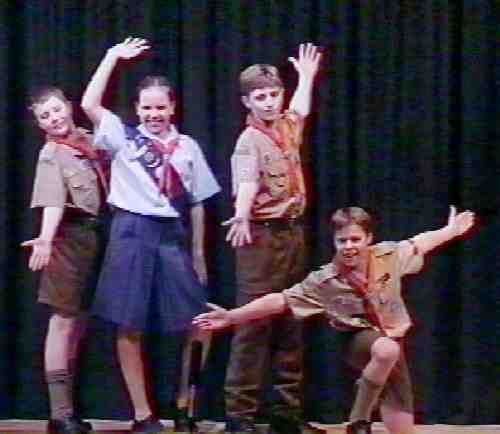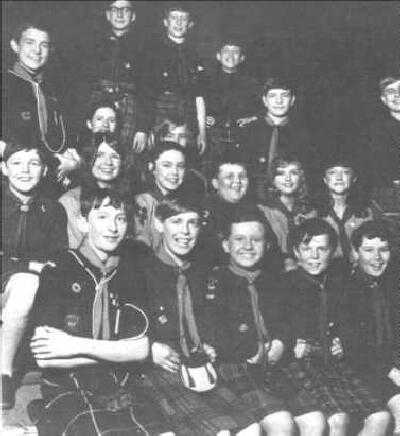
Figure 1.--The Australian Scouts and Guides are putting on a Gang Show in 1999.


Figure 1.--The Australian Scouts and Guides are putting on a Gang Show in 1999. |
A Gang Show is a variety show staged by Scouts and Guides--generally to a high standard carrying on the very best traditions of Gang Show and the theatrical arts. Gang Show had its beginning in England in 1932 when a young Rover Scout, Ralph Reader, who was making a name for himself in theatrical circles. In fact, Ralph was already a famous and sought after choreographer on Broadway-- but his life took a remarkable twist after he wrote and produced the first Gang Show to raise money for a local swimming pool. Recognising the worth of this form of training, Baden-Powell encouraged Reader to continue. Gang shows are still most common in England, but are held by Scouts around the world.
A Gang Show is a variety show staged by Scouts and Guides - generally to a high standard that Ralph Reader would recognise as carrying on the very best traditions of Gang Show and the theatrical arts. A Red Necker Gang Show (eg Reading, Oxford and the South-East Berks in England) symbolise the highest standards of excellence. (A Red Necker is
a prestigious award bestowed by the London Gang Show Fellowship. Red Neck of course means something very different in America.) A major Gang Show is quite an elaborate theatrical production. Gang Shows are commonly made up of over 200 people--not just the hundred-odd cast on stage--and covers all areas of the modern theatre from lighting, scenery, costume, music and orchestra, audio, special effects, and energetic ticket sellers.
The Story Gang Show had its beginning in England during 1932 when a young Rover Scout, Ralph Reader who had been a Senior Scout. Reader was making a name for himself in theatrical circles. In fact, Ralph was already a famous and sought after choreographer on Broadway--but his
life took a remarkable twist after he wrote and produced the first Gang Show to raise money for a local swimming pool. Recognising the worth of this form of training, Baden-Powell encouraged Reader to continue. He followed Baden-Powell's advise and went on to establish the world famous London Gang Show tradition. The first Gang Show had a cast of around 120 Scouts. Reader was not just the producer, but he devised sketches and wrote the words and music to hundreds of songs, including the world famous song "We're Riding Along on the Crest of a Wave" (1934). The Gang Shows were not long confined to London. Other towns and cities throughout Britain started their own Gang Shows which were "based on the London pattern". [Hazelwood, pp. 64-65.] The Gang Shows became very popular entertainment with Scouts and those of parents and friends of them. The London show for example, was much patronised by Royalty and was often televised. From that small beginning, the Gang Show has become one of the traditions of Scouting and has given Royal Command performances--the only amateur act to ever receive this honour.
The first Gang Show was held in England in 1932. They were popular throughout England through the 1960s. We note that they were still going string in England through 1999, although perhaps not the major events that threu once were. The chronology varies in other countries where gang shows were put on. We notice some in Australia and New Zealand in 1999. We are not sure to what extent gang shows are still being produced in other countries.
Sir Harry Secombe, Sir Richard Attenborough, Peter Sellers, Darryl Stewart, Max Bygraves, Spike Milligan, Norrie
Paramour, Dick Emery, Tony Hancock and many other stage and film stars were involved in Gang Shows early in their careers and have contributed in building the Gang Show tradition.

Figure 2.--These are members of the Glasgow Gang Show taking a break between scenes. I'm not sure of the date, perhaps in the late 1960s. |
Gang Shows then spread quickly to many other countries around the world. It was perhaps the biggest hit in Australia, but it has become a treasured facit of Scouting in many countries around the world. It is often said that a Gang Show is playing somewhere in the world every night of the year! It was especially popular in British Empire countries. For some reason in never caught on in America.
Gang Shows serve many purposes. They are an excellent training activity for young people , giving them confidence, teaching them teamwork. Creative activities are as much a part of the Scouting Training Scheme as is climbing, hill-walking or canoeing. We have prepared
information for Adult Leaders to show them how participation in
Gang Show can benefit the youth membership. Gang Shows are also an excellent way to publicise local Scouting. All members of the casr should be active in local Scouting.
Gang Shows should become part of the local community. Gang Shows aim to be as professional as possible, with modern content, but still upholding the traditions established by Ralph Reader. Most shows try to achieve a balance between the modern content and the music and
sketches that Ralph wrote, whilst realising that some of that material may need a new context for 1999 and beyond. Like every other Scouting activity, the organizers want as many people to participate in the show as possible.
Many Gang Shows have traditional audition. Some in order to expand participation have instituted Work Shops to replace auditions. Some swant all those in the youth and adult membership who want to be in the show to be able to participate.
Hazlewood. Rex. Scouting (Frederick Muller Limited, 1957).
Navigate the Historic Boys' Uniform Chronology Pages: Navigate the Historic Boys' Uniform Web Site: Navigate the Historic Boys' Uniform Web organizatiion pages:
HBU
[Return to the Main chronologies page]
[The 1900s]
[The 1910s]
[The 1920s]
[The 1930s]
[The 1940s]
[The 1950s]
[The 1960s]
[The 1970s]
[The 1980s]
[The 1990s]
[The 2000s]
[Activities]
[Biographies]
[Chronologies]
[Countries]
[Essays]
[Garments]
[Organizations]
[Religion]
[Other]
[Introduction]
[Bibliographies]
[Contributions]
[FAQs]
[Questions]
[Unknown images]
[Boys' Uniform Home]
[Return to the Main Boy Scout page]
[Boys' Brigade]
[Camp Fire]
[Hitler Youth]
[National]
[Pioneers]
[Royal Rangers]
Created: March 4, 2000
Last updated: July 3, 2003
